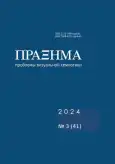The II Cross-Cultural Assembly dedicated to the 225th anniversary of Alexander Sergeevich Pushkin “Reasoning Is Above All Virtues, for Every Virtue Without Reason Is Empty”: Geopoetics, Media Aesthetics and System-Functional Grammar of Euro–Afroasiatic Cross-Border Territories (Barnaul–Samarkand, Russia–Uzbekistan, 10–12 April 2024) is overviewed. In the year of Pushkin’s 225th anniversary celebration, the Department of Media Communications, Advertising Technologies and Public Relations. Altai State University, and the laboratory Center for Language Management and Communication Marketing, Institute of Humanities, Samarkand State University named after Sharof Rashidov with the support of Rossotrudnichestvo in the Republic of Uzbekistan held a cross-cultural assembly, the purpose of which was to gain an understanding of the modern generation’s sensitivity to the word, formed by the Russian language culture, permeated and inspired by the poetics of Pushkin's Word. The Assembly participants and organizers, representatives of 25 countries, managed to jointly create an amazing emotional and intellectual atmosphere based on a fine sense of their language’s word, understanding of the meaning put into the word by other generations, and the ability to present the history of their people in a way emotionally and stylistically accessible to listeners. Pushkin’s works are a model of a life of a citizen worthy of imitation, a feat of an honest Russian, a nobleman who is proud of his family history − the history of his fatherland, dictating to him the forms of creative work based on filial piety. The Assembly’s conceptual design assumed the creation of communication spaces of three types: scientific (Plenary Session, Settings), discussion (Table Talk, or Round Table), literary and artistic (Literary Lounge), which was supposed to form a special sensual world of belonging to Pushkin’s semantic innovation – a new semantic correspondence – based on a continuous change of perceptions. The Assembly’s compositional design was built taking into account the cross-cultural specifics of exchanging meanings through moving from one association to another, to finging a common world shared by all participants. A new predicative correspondence, a living metaphor, distinguished communication within the scientific space, which was formed during the speeches and their discussion at the plenary session and settings. The Assembly’s important component was the holding on the second day of a table-talk, The Life Worlds of A.S. Pushkin: The Modern Man’s Sensitivity in the Focus of Mental Anthropology, which was attended by representatives of Egypt, South Africa, Bolivia, Libya, Congo, Mongolia, Uganda, Zimbabwe, Angola, Nigeria, Bangladesh, Iran, Samali, China, Afghanistan, where an environment for the birth of a new semantic correspondence was created, a signifying matrix correlating semantic innovation with productive imagination. On the third day of the Assembly, the Literary Lounge “What Is in My Name…” was held. Pushkin’s works not only reveal the depths of the world around to attentive contemplators of Life, but also inspire them to create their own poetic works in which the heart and Soul speak to the world. The Literary Lounge aimed to reveal the creative potential of young people studying at educational institutions in Barnaul and Samarkand, to involve educational institutions in multicultural and educational events and projects that ensure the creative and innovative environment development of cross–border territories. In accordance with the wishes of the audience, in addition to novice poets, readers were also able to participate in the meeting of the Literary Lounge. In this way, two leagues were formed based on applications from students of Altai State University and Samarkand State University, and lyceum students of the Altai Krai Pedagogical Boarding Lyceum. At the deep ontological level, the Assembly made it possible to attain the state of “being like Pushkin” (être-comme-Pouchkine): to reverently treat one’s culture, the word given for salvation and admonition, and nature that created one’s family and Fatherland.
 9-36
9-36


 37-57
37-57


 58-90
58-90


 91-116
91-116


 117-137
117-137


 138-164
138-164


 165-190
165-190


 191-203
191-203












